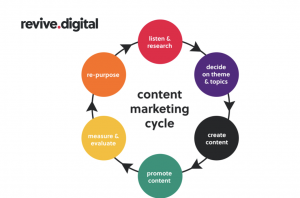Content marketing is an essential part of digital marketing strategies, but do you know what it is? Find out, right here.
Content marketing is everywhere. If you don’t recognise it, you’re probably not too sure what it is. The fact is, content marketing is extremely integral to a lot of digital marketing strategies, including search engine optimisation (SEO). Unlike a campaign, content marketing can be an endless process, where work is constantly improved and built upon. In this post, we’re going to explain what content marketing is and how the process works.
We’ve spoken to a leading digital marketing agency, about the importance of content marketing. We’re going to outline the process of content marketing, how it works and how it can help bring in results. Find out about the content marketing process, right here.
Content Marketing – what is it?
Like we’ve said, you’ve probably seen content marketing somewhere, you may just not recognise it. It can come in the form of blogs, videos, images, podcasts and other content forms. Content marketing is a little different to other forms of digital marketing. Whilst other forms of digital marketing look to directly advertise, content marketing is about providing something of value to consumers.
For example, a big supermarket chain might release a recipe including their products, in order to provide consumers a tasty meal whilst marketing their products. Both parties get something out of it – however, it’s more for the consumer as opposed to the business. Content marketing is about creating brand awareness, making customers into brand loyalists, and giving them valuable and shareable information.
Content marketing goes hand in hand with SEO, and a lot of SEO strategies involve creating content, as SEO agency Robben Media will attest to. Search engines crawl websites in order to determine their relevancy, which involves indexing content analysing keywords, so users can find relevant answers to their search queries. Creating blogs and improving website content is an essential part of SEO.
The Content Marketing Process
This simple graphic explains the content marketing process cycle, but we’ll go into greater detail further down.
 1. Listen & Research
1. Listen & Research
Finding out what your consumers want is key in content marketing. It’s no good creating content around something that isn’t being searched for or that consumers aren’t interested in. So, the first step of the content marketing process is to research and listen. Find out what consumers want to know and see and implement it into your content.
2. Decide on Theme and Topics
So, once the research is completed and you feel like you’ve got an idea of what consumers want to see or know, it’s time to decide on the themes and topics of your content. Whether it’s video, written, audio or an image, you need to make sure that your content is in line with your brand, as well as being appropriate for your audience. Look at trends on social media, what your users are searching for and if your content strategy is part of your SEO strategy, find relevant keywords for the content.
3. Create Content
There are 4 different types of content we’re going to talk about: Written, Video, Image and Audio.
- Written: this can include articles, blogs and website content too. The point of this is to make it readable for your audience, provide them with value and make sure it is informative over promotional. If it’s for SEO purposes, make sure it is optimised properly too.
- Video: when making video, it’s important to hit the same bases as written, but it needs to be on brand, planned well and filmed well – it needs to be of high quality in order to showcase your brand in a good light. If you don’t have experience in creating video content and you want your videos to have a professional look, you should contact a Video Production Company to assist you in the process.
- Images: whether it’s images for social, your website or infographics, it needs to be high quality as well as designed well – again, it needs to be on brand too.
- Audio: podcast should be edited well, be concise and high quality too.
All of the aforementioned need to provide something of value to the consumer.
4. Promote
Creating good content is worthless unless it is promoted effectively. It needs to be pushed across all elements of your business, where it can. On the home page of your site highlighting a new blog post or video, on your social media with links to the blog/video/podcast/image and even in email marketing messages too. The more you promote it, the more traffic you’ll bring in to your site and the more likely it will be shared around too.
5. Measure and Evaluate
It’s essential to make sure that you monitor the success of your content. How many people saw it, how many people watched and how many people interacted with your site. Did it lead to any conversions? Were you able to reliably generate leads from your outreach, or did the marketing campaign itself serve as that funnel, inspiring the use of a lead generation agency next time around? These are all essential elements that need to be considered once you’ve moved on to the next piece of content. It’s a great way to show your superiors the effectiveness of it, and also to help you understand what is working, and what isn’t. Are videos more popular with your users or are podcasts? How many shares did one of your blogs have vs. the share of an infographic? It all factors in to the success of your content.
Of course, this is a lot to take in and manage, which is why many companies prefer to use monthly SEO services that can do all of the hard work for them.
6. Re-purpose
Sometimes, your content will do really well. So, how what next? Well, you can re-purpose it. Whether it’s updating and improving blogs with videos and images or transcribing a podcast or video into written form, if it’s done well in the past, it has the potential to be re-used and improved for audiences.
Following this process means that you’ll be able to plan, create, measure and re-use your content endlessly!

